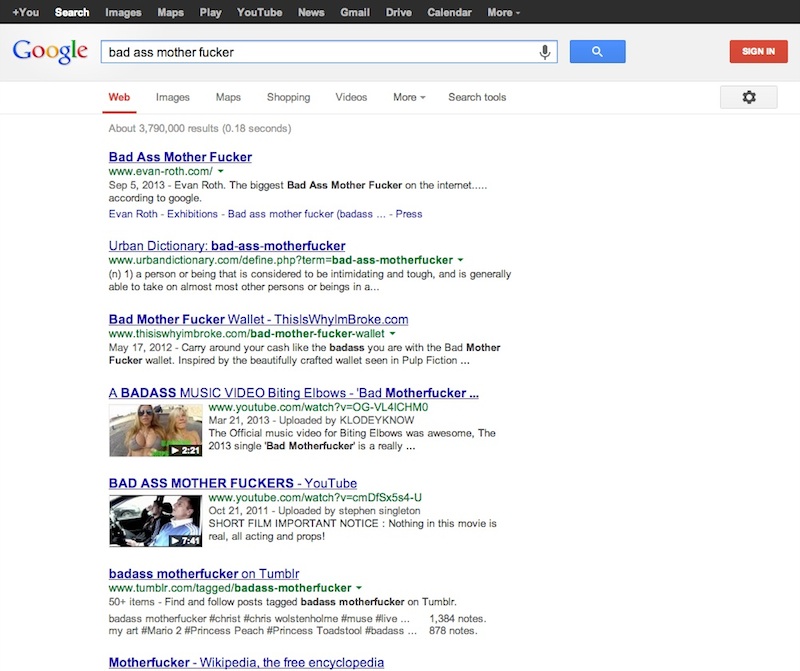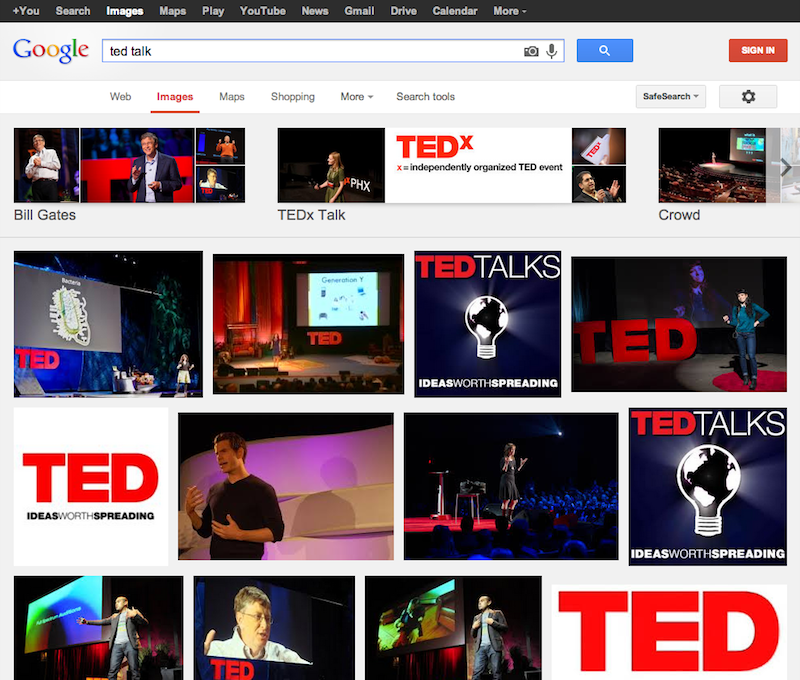
A screenshot of a Google search for “bad ass mother fucker” in September 2013.
While not as easy to do as they once were (although John Fekner and Saber are essentially doing small-scale variations on this on different platforms), Google bombing is one of the most fun forms of invasive viral art. Especially since now they often require some audience participation. A Google bomb is a word or phrase that, when searched on Google, comes up with a result that required some odd search engine optimization to achieve. Some famous Google bombs include “santorum” (for which this site was the #1 result for a very long time rather than politician Rick Santorum’s own website) and “miserable failure” (which at one time brought up results relating to President George W. Bush). While of course there are some people who search “santorum” knowing exactly what they’re going to see and who spread it along the same avenues as organic viral art, there are plenty of people who search for “santorum” looking for the politician’s homepage only to discover the Spreading Santorum page instead.
Evan Roth took the idea of a Google bomb and applied it to his own website as an artwork. Instead of identifying his site with something like “miserable failure,” he decided to identify his website with the phrase “Bad Ass Mother Fucker.” Using various search engine optimization techniques such as code on his own website and making sure that people who write about him online include the phrase “Bad Ass Mother Fucker” in their articles, Roth is now the #1 hit on Google when you search “Bad Ass Mother Fucker”. And of course, now people do things like write Evan Roth is a Bad Ass Mother Fucker and link to Roth’s website, which just further solidifies his position as the top result. It’s a Google bomb, it’s an art project, it’s clever marketing, it’s invasive viral art and it’s kinda badass.

A person participating in Evan Roth’s Ideas Worth Spreading project at Eyebeam in NYC. Photo courtesy of Evan Roth.
Roth’s Ideas Worth Spreading piece blurs the line between invasive and organic viral art because sharing is basically part of the piece in a way that it is not with most of his other projects. The artwork consists of a stage setup indistinguishable from the stage at a TED Conference and a yellow microphone like the kind that would be used at a TED Conference (a conference with the tagline “Ideas Worth Spreading”). A TED talk is one of the most prestigious lectures a person can be invited to give. Past speakers have included Al Gore and JR, and the most popular videos of TED talks have gotten millions of views online. At an installation of Ideas Worth Spreading, anyone is welcome to get up on “stage” and have their picture taken as if they are giving a TED talk. If you had that kind of a photo, wouldn’t you share it? When Ideas Worth Spreading was shown at Eyebeam in 2013, plenty of people did share photos of themselves at the piece with captions that implied they had really just given a TED talk. Most organic viral artworks might be sharable and worth sharing, but they do not require sharing to be complete. Ideas Worth Spreading is hardly complete without sharing, even if the sharing is done with the user’s permission. At this stage, Ideas Worth Spreading is tricky, but it’s still organic viral art. The project eventually did result in some invasive viral art (and perhaps that was the point all along) when Roth found that images from the piece began showing up within the first few results of Google Images searches for “Ted Talk.” At that point, the Ideas Worth Spreading images were intruding into unexpected places, in a sense even tricking Google, and became invasive viral art. The project has moved beyond a prank involving sharing and become a piece that is infiltrating and imposing itself on an audience.

A screenshot of a Google Image search for “ted talk” in September 2013. Note the woman in the blue/green shirt on the far right of the first row of results. She is not giving a “real” Ted Talk. She was a participant in Ideas Worth Spreading when it was installed at Eyebeam.
The portion of Ideas Worth Spreading that deals with the images appearing on Google Images is a visual variation on Google bombing. When I posted about the project on Vandalog, Roth tweeted me to say, “Thanks @vandalog, make sure to add alt=”Ted Talk” to your img src tag!” With that change, search engines looking at my site would identify the photo I posted as related to the phrase “Ted Talk” and it would be more likely to have a higher position in search engine results for the phrase.
Comparing art distributed online to street art and graffiti, Roth said, “You’re hitting people in these spaces, whether you’re talking about viral-y or meme-y type things online or you’re talking about someone who is going to work and commuting and having to see something on the subway system or something on their walk as they go down the street, you’re hitting people in places where they weren’t expecting to experience it.” That’s invasive viral art, and that’s basically what happened with the images that came out of Roth’s Ideas Worth Spreading project as well as Bad Ass Mother Fucker, although the Ideas Worth Spreading images unexpected hit people on such a subtle level that viewers should not actually be aware that they are experiencing anything abnormal.